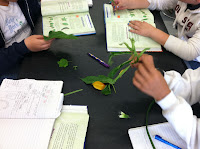First, we started with the celery experiment. The kids weighed the celery, and made careful note of whether or not there were leaves present. Then, the celery was placed in a vial with or without water. After a day, the celery was weighed again, the amount of water left was recorded, and students drew conclusions about how the celery took in water.
Basically, the celery in the water wilted a bit, took in red die, but did not weigh any more than it did to begin with, even though there was less water in the vial. Since we had a control (a vial just with water) we measured it to see if evaporation could account for the lack of water in the vial. There was the same basic amount of water in the control as there was the day before. So evaporation wasn't the culprit. With the red dye in place, we could see the tubes inside the celery. The students were able to come to the conclusion that the water just passed through the celery. Since there was less water left in the vial containing the celery with leaves, they were further able to conclude that the leaves had a big impact on how much water was taken in. The celery outside of the water actually did weigh less and was super wilted. They concluded that this meant nothing was getting to the cells and it just died completely.
We then looked at various leaves and the structures inside of them. After taking careful notes on the observations, we discussed the ways scientists classify leaves and talked about how the xylem and phloem helped the leaves to get the nutrients to the rest of the plant (again, don't I sound so scientific??) Our science journals are now filled with drawings and information about how leaves are classified.
Finally, we went back to the classroom to read up on all that we had learned. Instead of having the students simply answer the questions in the back of the book, I had them create a foldable with the information. The labels on the front are the basic idea of what the question was about (that the kids decided upon themselves....getting a little more test prep in for The TEST), and inside they searched the text for the answers (again, prepping them to find evidence in their reading...can't let a minute go by without prepping for The TEST). The foldable kept their attention and made them think they were doing something other than answering the questions in the book. As a result, their answers were far more detailed and useful.


So there you go....more science instruction straight from my classroom. I swear, if you come back in 2 years, I will have AMAZING ideas. But for now...this is what you get ;)





I love it!
ReplyDeleteThe Science Penguin
This comment has been removed by the author.
ReplyDeleteCool experiment! Like the foldable too. Don't put your ideas down :-)
ReplyDelete-Charmaine, Community Advocate at QuickSchools
I heart the foldable :)
ReplyDelete❤ Mor Zrihen from...
A Teacher's Treasure
Teaching Treasures Shop
This looks like a great experiment! Did you design it, or are you using a curriculum? If it's a purchased program, I am curious which one.
ReplyDeleteThanks!
Love this experiment. I'm actually teaching plants right now. If you don't mind sharing, how do you structure your science class? Just curious if you read the chapter first, take notes, do vocabulary? I'm looking for an effective way to teach the science chapters and wanted to know if you had some advice?
ReplyDelete